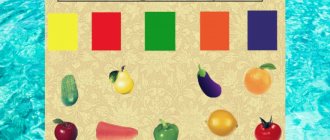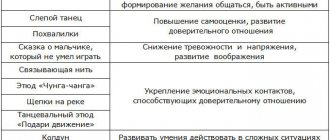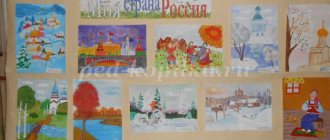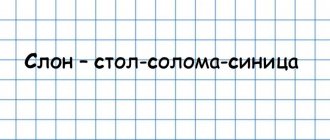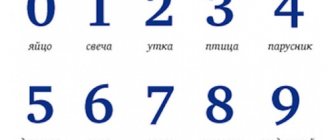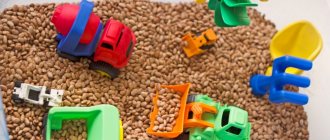Sand therapy for children makes a significant contribution to the development of cognitive and creative abilities, speech, fine motor skills and tactile sensitivity. Sand helps a child get rid of negative emotions, relax and relieve stress. Joint play and creativity with parents have a beneficial effect on family relationships.
Benefits of the lesson
Sand as an art material has several advantages. And most importantly – a relaxing, therapeutic effect. The child gets rid of the effects of stress, and emotional stability returns to him. Sand painting is used to treat sleep disorders, neurotic disorders, and anxiety in children. Sand art is also useful for healthy children; it allows them to calm down after failures, get rid of low self-esteem and the phobia of becoming a loser. The child sees that a bad drawing can be corrected at any time.
The second benefit of sand painting for children is a developmental activity. The technique improves finger motor skills, sensory perception and creative thinking. Drawing usually involves both hands, which has a positive effect on the development of both the right and left hemispheres of the brain. For schoolchildren, fiddling with sand improves writing skills. It is useful to use the technique with children for whom studying is a burden. In this case, sand painting becomes a good addition to homework and allows you to consolidate school knowledge through art.
The third benefit of drawing on sand is the revelation of artistic potential and the manifestation of imagination. The technique has no restrictions and strict rules. You can draw with your hands and various devices. The loose texture of the material allows you to create images of any complexity and degree of detail. Drawing with sand is available for toddlers, middle school preschoolers, and schoolchildren.
The history of sand therapy
CONTENT:
Back in the 20s of the 19th century, analyst Dora Kalf identified the healing properties of sand. Sand therapy is based on the symbolic manifestation of the unconscious and often becomes a source of development and internal growth of the individual. The author connected the content of sand paintings with a person’s state of mind. It was concluded that with the help of a sandbox, a child creates his own model of the world around him, transferring his own anxieties and concerns into it.
Sand therapy was developed in the works of Margaret Lowenfeld, who used this technology in working with children with psychological problems. She developed her own method called the “world-building technique,” which includes principles of work and exercises for working with children of different age groups. At this stage, sand therapy is distinguished as a separate type of art therapy; it can be used in child psychoanalysis, cognitive behavioral direction, Gashtalt therapy and family psychotherapy.
Sand painting materials
To learn to draw on sand, you need to purchase a list of materials and equipment. All of them are affordable, you won’t have to fork out a lot of money. Here's what the young artist will need:
- table with sides and a lighting device at the bottom;
- sand;
- antistatic agent in a can;
- additional equipment - art brushes, sticks, sieve, templates;
- a wide and flat brush for sweeping grains of sand from the corners of the table.
An antistatic agent is necessary to prevent sand grains from sticking together, which is inevitable when quartz material is used repeatedly. The spray should be sprayed before each lesson. A regular antistatic agent is suitable, preventing synthetic clothing from sticking to the body.
You can buy a table or make it yourself. Homemade design - sides connected in a rectangular shape with a bottom made of frosted glass or plastic up to 5 mm thick. It is necessary to fix the lamp from below so that diffused light is obtained. The lighting can be anything: in the warm and cold range, even colored. The legs of the table should not wobble, otherwise when drawing you will not be able to draw neat lines.
The finished table is a structure with sides and a bottom in the form of an illuminated tablet. The optimal format is 130x70 cm, but for a child 70x50 cm is enough. The height of the sides should be at least 6-7 cm, but from the side of the drawer it is only 3 cm, otherwise it will be inconvenient to draw the lower elements. It is necessary to leave indentations for sand 10-15 cm wide on the right and left sides. It is advisable that these areas be in the same plane as the space for drawing, this makes it more convenient to use many techniques. But some ready-made tables have tray recesses on both sides.
Any sand will do. You can buy an aquarium one at a pet store, and a special one for creativity at a supermarket in the children's section. You can contact a children's and adult creativity studio where sand animation is practiced, if there is such an institution in the locality. They probably won't refuse to sell a small amount of sand. The fraction of the material can also be any. It is advisable to get different ones, since fine sand is convenient for creating tones and halftones, and coarse sand is convenient for creating large image details.
If there is a river near your house, you can dig up sand on the shore. You just have to filter it through a fine-mesh sieve, then rinse. The washing procedure looks like this:
- Pour 4-5 kg of sand into a bucket. This is the standard amount for drawing.
- Fill with water to the edge of the bucket.
- Stir gently with your hand or a large spoon.
- When dust and dirt particles rise to the surface and heavier grains of sand settle to the bottom, carefully drain the water.
- Repeat the procedure until the drained water becomes crystal clear.
- Dry the cleaned material on the balcony if the weather is sunny, or on a radiator, or in the oven.
You can replace sand with semolina, finely ground salt, and to create darker and more contrasting elements of the image - ground coffee.
Bulk material should be renewed once every 3 months, and if the child draws every day, then once every 1.5 months. If this is not done, the sand will become less pliable, since with constant friction the grains of sand are destroyed and the structure of the material softens.
Who is suitable for sand therapy?
Using this method can be useful for every child, even if he does not have personality disorders, as a method of developing skills and abilities. But there are cases when the use of sand animation for preschoolers is especially recommended:
• If you have fears or severe anxiety;
• With mental retardation;
• With diagnosed neurosis, nervous tics;
• With low self-esteem;
• During outbursts of aggressive behavior;
• In case of difficulties in relationships with others (parents, teachers, peers);
• For depression, apathy, isolation, suicidal thoughts;
• For speech therapy disorders;
• In case of violence or psychological trauma.
A preschool child often has difficulty formulating his experiences. Sand animation therapy will help him overcome this barrier and cope with negative conditions in a playful way.
Sand painting technique
The technique of creating sand drawings is not difficult, but when teaching a child you will have to be patient. The main tool is the artist’s hands, but it is possible to use auxiliary devices.
Before your child starts drawing, introduce him to the art material. Offer to immerse your hands in the sand, pour it from one palm to the other, and talk about your feelings. After becoming familiar with the material, you can begin to learn drawing methods.
Fist rash
This is the first DIY sand painting method that a preschooler should master. Ask to take the material into your palm, clench it into a fist, and turn it along a vertical axis so that the grains of sand fall down. Explain to your child that the amount of sand spilled out is regulated by squeezing and relaxing the fist muscles. If more grains of sand spill out, the “mound” becomes denser and darker. This creates images with a smooth transition from light to shadow.
Lines of different sizes
Next, preschoolers master drawing lines of different thicknesses, lengths, and tortuosities. Teach your child to draw dotted lines, curls, and waves. This is the best method of getting used to the original drawing technique for a preschooler of the younger group.
To create a thin straight or curved line, you need to pour a strip of sand from your fist, then put two fingers together - your thumb and forefinger, and run them along the strip. You will get a line of the same thickness throughout. Explain to your child that you should not strain your fingers too much, otherwise the image may turn out uneven. If a thicker line is required, the fingers need to be connected diagonally.
Drawing with different parts of the hand
When drawing on sand, different parts of the hand are used. They move one or more fingers over the material, move them and spread them apart. Large elements and thick lines are depicted with a fist and the edge of the palm extending from the little finger. To create many small details, they poke the sand with their fingertips, and draw fine lines with their nails.
Drawing on dark and light
When the above-described drawing methods have been mastered, you can begin to select a compositional basis. You can draw “in the dark”: fill the background with sand to make light lines on it. Or “in light”, that is, create a dark sandy image on an empty background. Typically, professional artists combine these methods. At the initial stage, it is enough for a child to master them separately.
Drawing with aids
To make sand drawing more fun in kindergarten, let children use not only their fingers and palms, but also additional devices. What you can draw:
- Artistic brushes of different hardness. They are convenient to depict hair and wool.
- Toothpicks, hashi sushi sticks, cooking skewers. Optimal for creating thin and graceful lines, fancy patterns, and detailed drawing. It is advisable to use wooden products; they will not scratch the plastic bottom of the drawing table.
- Comb, small rake. With their help, you get neat waves.
- Colored paper. It is placed on the table and sand is poured on top. Uncovered areas of the design are multi-colored. The method is applicable for creating floral motifs and abstract patterns.
- Funnel. Pour sand through it, create slides, paths, patterns - a fascinating activity.
- Fine mesh sieve. With its help, the table is covered with a thin layer of sand, which can become the background basis for the drawing.
- Stencils. You can use ready-made ones. Or cut them out of plastic lids or cardboard for practice. Or use different flat objects for this purpose. You need to place them on a clean table surface, sprinkle them with sand, and then carefully remove them.
- Pendulum. Attach a round-shaped weight to the thread and give it to the child. Let the pendulum swing over the sandy surface, creating patterns of different depths. This is a wonderful method of strengthening the skill of correct pressure and speed of movement when creating a drawing.
- Cylinder with patterns. You can use a toilet sleeve. Apply patterns on it with a thick layer of glue. Wait until it dries, then give it to your child. Let the cylinder roll on the sand, creating patterned paths.
Master class “Sand fantasies”
Master Class
"Sand FANTASIES"
Author-compiler:
Platonova E. A., teacher of additional education
TsVR "Eureka" - a branch of the State Budgetary Educational Institution Secondary School named after. N. S. Dorovsky s. Podbelsk
Target:
- introduce sand animation techniques;
- develop interest in working at the sand table
- show the possibility of creating animated videos using the sand animation technique in the future.
Tasks:
- introduce children to an unconventional direction of fine art and technical creativity - sand painting;
- support and create conditions for the development of creative potential;
- develop self-regulation of emotional reactions;
- improve communication skills, develop joint activities of children;
Participants:
students in grades 3-9.
Materials and tools:
drawing table, sand, screen, projector, camera, USB cable.
Visual aids:
slide presentation, film “
Creation of the World”
.
Sand animation or sand painting is a very exciting and relaxing process that allows you to develop your imagination and reveal your child’s inner world. Sand is a material that attracts. Its flowability attracts both children and adults. It is very useful for children to “communicate” with sand and any bulk materials.
Playing with sand is not only entertainment for a child, it is the development of tactile sensations, fine motor skills of the hands, speech, imaginative and spatial thinking, and the child’s creative potential. With its touch, sand can have a positive effect on the psyche. And this applies not only to children. Even adults, lost in thought, can spend a long time pouring sand from hand to hand. Such manipulations with sand can have a calming effect on a person’s psychological state and his emotional feelings. Parapsychologists say that sand takes away negative mental energy, and the touch of sand stabilizes the emotional state.
Sand animation differs from classical drawing. To start drawing on sand, you do not need to have any special skills or education. Drawing with sand is accessible and useful to all children. Unlike regular drawing, sand animation involves working with both hands at the same time. This promotes the development of interconnection between the hemispheres of the brain. Having mastered the basics of sand animation, children begin to invent and bring to life fairy-tale plots themselves.
Sand allows you to keep your child working longer. It is easier to correct mistakes on sand than on paper, where traces of mistakes are always visible. This allows the child to feel successful.
Master class summary
Organizational stage
Greetings.
Good afternoon, dear guests and colleagues!
I, Elena Aleksandrovna Platonova, are a teacher of additional education at the Center for Extracurricular Activities.
I present to your attention the “Sand Fantasies” master class.
- Introduction to the topic
From the history.
Sand painting, sand animation, sand fantasy, free-flowing animation or powder technique is a style of fine art as well as a technology for creating animated films. Light powder, usually cleaned and sifted sand, is applied in thin layers to the glass; you can also use any other bulk product: salt, semolina, ground coffee. Then, using an overhead projector, the resulting image can be transferred to the screen.
Having originated in the West, a new, unique direction in art (Sand Art) sand animation came to Russia several years ago. The inventor of the style is the Canadian animator director Caroline Leaf. The first film created
Caroline - “Sand, or Peter and the Gray Wolf” was made using the powder technique, which was then completely unfamiliar.
Black powder scattered on the glass, and Caroline Leaf used her fingers to collect this powder into certain shapes and images. Moving it, she told the story about Petya and the wolf to Prokofiev's music.
Sand animation is often performed “live,” with the artist changing sand paintings right in front of the audience.
At the end of the twentieth century. The work of the Hungarian Ferenc Cako becomes widely known. He perfectly mastered the sand technique of the Canadian Leaf, and his first success came in 1982. In 1999 he was awarded the title of People's Artist of Hungary. Tsako's most famous performances include animation at the Oscars. The artist’s animation, shot as a film, receives main prizes at film festivals in Cannes (1987), San Francisco (1991), Berlin (1994), Barcelona (1998), etc. And today we will watch his film “The Creation of the World.”
- Main stage
2.1.Watching the film
“Creation of the World”
by Cak ó Ferenc 2.2 Step-by-step work and drawing methods.
Guys, we watched the work of a professional on stage, and you and I will begin to get acquainted with the basic techniques of sand painting.
Work on the drawing begins with the background. There are two possible background options, that is, we can draw either dark on light, or light on dark. (I show with examples). We collect sand into our fists and scatter it in an even layer on the glass. To draw on a light background, take a little sand into your hand and, releasing it in a thin stream from a clenched fist, draw the boundaries of the images.
The drawing can always be corrected. There is no need to be afraid of making a mistake. This is one of the beauties of sand painting - everything can be fixed.
Technical elements of drawing:
- With a fist.
- Palm.
- The edge of the thumb.
- With a pinch
- Little fingers.
- Simultaneous use of several fingers.
- Symmetrically with both hands.
- Cutting off the excess.
- Fist pouring.
We analyze each technique on a light table.
Having mastered the basic technique of drawing on sand, children are invited to get acquainted with the sand themselves, create images based on a read fairy tale, poem, etc. - what the children remember most or impressed the child with. It is necessary to provide a free approach to the table with sand, where they can independently sketch individual objects or images of their own composition. Some children can write numbers, letters or words, etc., that is, whatever they want at the moment.
The most amazing thing about sand animation is transformation. It is very important that one image flows into another (we use line spots and think about it). Very similar to a children's game. When a squiggle is drawn, in the next drawing it turns into something. It’s not difficult to come up with transformations, but it’s difficult to maintain a storyline. So that all transformations are part of one story.
Figure No. 1
We begin work by sprinkling sand in a fan shape and scattering it. Draw a circle in the sand and draw many rays from it. Be sure to add eyes and a smile. The result will be a cheerful sun.
In the center we draw a rectangular roof of the house. Sprinkling sand, we build a chimney on the roof and draw smoke with our fingers in a circular motion. We fill the walls of the house with sand, in the center there is a square window, from the house we draw a road and trees. Near the house in the foreground are silhouettes of children.
Figure No. 2
The first drawing is dusted with sand. Then, at the top we draw a month, stars, and low trees below.
On the side of the sand we draw a vertical line. And to the right and left of it there are small branches, needles, it turns out to be a large Christmas tree branch.
On top of the drawing, lightly dusting it, we draw a New Year's toy - a ball, flying snowflakes. Further, by arranging the snowflakes in a special way, you can show the wind, blizzard, etc.
Results
Using a special technique, the children create sand drawings on the light table that smoothly transition into one another. We draw children's attention to expressiveness - the images should be spectacular, unexpected, but at the same time seem to grow out of each other. We teach children not to remove the previous layer of sand from the table and not to start each new frame with a “clean slate”. Each sand drawing is universal, so such animation conveys any emotions and moods of the child and can express any idea.
Drawing with sand is an immersion in a fairy tale, a world of fantasy, and whimsical images. Touching the sand scattered on the illuminated glass for the first time, you feel its warmth, its fluidity, its movement. Creating a sand painting is a fascinating process, it touches all areas of the senses, awakens creativity, relaxes and inspires at the same time.
Thank you for your attention!
The health-saving effect of sand painting
- The development of the child’s thinking and speech is stimulated
- Relieves nervous tension
- Helps get rid of negative emotions
- Develops figurative and logical thinking
- Increases resistance to stress
- Imagination develops
- Fine motor skills develop
Sand painting is a way to relax. Immersion in a pleasant flowing state of calm creativity, contact with natural matter relieves stress, any tension, and fears.
This process has a positive effect on the speed of development of cognitive processes, that is, they train attention, concentration, imagination and imaginative thinking. This is necessary even for adults, let alone children. In addition, in this way it is possible not only to unleash creative potential, but also to develop communication skills. Also, drawing with sand on glass, like any art therapy, helps to find harmony with oneself, let go of psychological problems, and cultivate a positive attitude towards the world. Naturally, this is useful and purely physically, because it develops fine motor skills.
Bioenergeticists claim that such close contact with sand cleanses the energy, stabilizes the emotional state, helps to relax and relieve stress.
Sand animation allows you to plunge into a completely different unusual world of sand drawings and create your own unique work.
Literature:
- N.V. Dubrovskaya “Drawings hidden in fingers”, “Childhood - Press”, 2003.
- Mariella Seitz “We write and draw in the sand. Tabletop sandbox", "Moscow. Int", 2010.
- T.D. Zinkevich-Evstigneeva “Workshop on sand therapy”, St. Petersburg, “Rech”.
- u-sovenka.ru Drawing lesson No. 5. Sand painting - Sand show at home!
Exercises
Here are some popular sand painting exercises on light tables for children:
- Letters. The lesson is useful for older preschoolers and younger schoolchildren who are learning to write. Spread sand on the table in a dense layer. Let your child learn to write letters beautifully and develop finger motor skills.
- Water landscape. To create it, walk with your outstretched fingers along the sandy surface, imitating waves. At the top of the composition, make thin strokes with your nail - these will be distant ripples. Draw the horizon with the edge of your palm, remove the excess in the upper part - this is the sky above the reservoir.
- Clouds. Take sand into your fist. Pour it out in a thin stream, making circular, non-sweeping movements.
- Maple Leaf. Draw lines that form the outline and veins of the leaf. Sharpen the outline by running your finger along the outer edge of the line, moving the sand inward. Use your fingernail to follow the veins. Outline the border of the petiole.
- Sun. Take sand into your fist and lift it 20-30 cm above the table surface. Pour out evenly, trying not to move your hand. Grains of sand, falling from a height, bounce off the plastic surface, form a ring, and the middle remains empty. And its diameter is wider, the higher the hand is raised.
- Mountain landscape. Spread the sand in a horizontal direction using quick zigzag movements. Use the edge of your little finger to walk along the upper part, removing the excess to create a relief.
Sand animation for preschool children
The highest skill is shooting sand animation, in which the artist continuously creates images that smoothly flow into each other. And he does this by making the minimum possible number of movements. This is a complex art that requires the master to act quickly and have impeccable artistic skills.
Real animation is unlikely to be within the capabilities of a preschooler, but something simple, for example, a tree that is bare in winter and blooms in summer, he can easily depict after practicing for 3-4 lessons.
Introducing a sand painting master class for children:
- Spread the material evenly.
- Place the pad of your finger on the sandy surface and move upward. Thin the line by gradually raising the pad. You will get a tree trunk.
- Draw branches with your little finger. Make them curved rather than straight so they look natural. It will turn out to be a tree in winter.
- Now make it summer. Sprinkle sand in a wide layer on the ends of the branches - this is the crown. Also sprinkle horizontally under the tree - this is grass.
- Randomly poke your fingers along the crown, pressing to different depths, to make leaves. Draw blades of grass by running your fingernail vertically under the tree.
- Adjust the contour of the tree crown and remove excess sand.
- The animation can be continued by making it autumn. To do this, place a few spots under the tree with your fingers - these will be fallen leaves.
Sand therapy session.
In preschool age, this method is widely used by speech therapists and psychologists, taking into account the final goal and personality characteristics of the child, the specialist determines the goals of the classes and the exercises necessary to achieve it. Classes can be conducted both for a group and separately for each preschooler.
Many experts note a positive effect after the first session. Children can open up and establish close contact with a psychologist who, by interpreting what is happening, can reveal their deepest experiences. Very often these are unconscious experiences that could not be recognized before. The main goal of psychological influence is to realize and work through your problems, find solutions and a way out of the situation.
Sand therapy stages:
1. Working with sand. At the first stage of work, the child gets acquainted with the sand and the available figures and figurines. It is especially important for a psychologist to observe the actions of a child, paying attention to his behavior and actions.
2. Discussion. After the end of the game, a joint discussion of the progress of the game is held. It is important for a specialist to find out the individual explanation of each game character. The psychologist can interpret the meaning of the figures and their impact on the patient's life problems. During this stage, the psychologist should help identify the problematic situation and push towards its solution.
3. Repeated therapy. Having identified the client’s superficial problems, it is necessary to continue systematic work that allows one to study deep-seated experiences. It is necessary to work on the problem comprehensively, looking at the causes and solutions from different angles.

